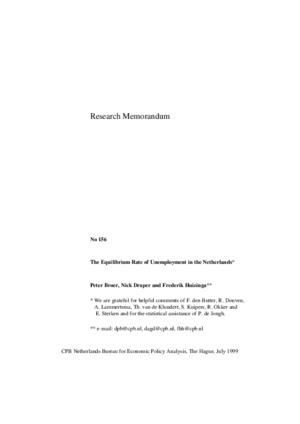The equilibrium rate of unemployment in the Netherlands
CPB-ers analyseren evenwichtswerkloosheid
We are sorry, unfortunately there is no English translation of this page.
This paper attempts to explain the apparent non-constancy of equilibrium unemployment by developing and estimating a structural model in which equilibrium unemployment is endogenous and results from the interactions of wage bargaining and the price and employment determination of firms. We find that the three major determinants of equilibrium unemployment are tax rates, the replacement rate and the real interest rate. The rise in unemployment in the 1970’s and early 1980’s was mainly due to a rise in the first two factors. That equilibrium unemployment remained high when tax rates and the replacement rate were reduced in the 1980’s and early 1990’s is attributed to the rise in real interest rates during this period.
Key words: equilibrium unemployment, wage bargaining, labour demand, price setting

